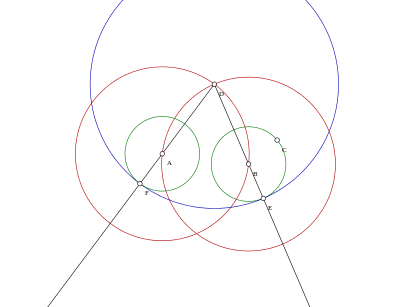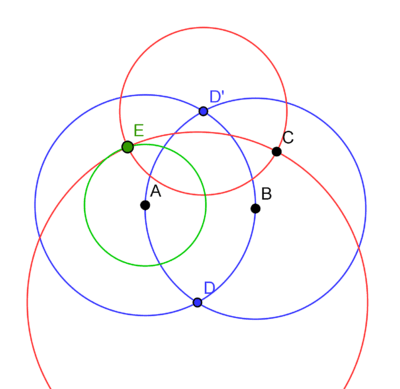Compass equivalence theorem
The compass equivalence theorem is an important statement in compass and straightedge constructions. In these constructions it is assumed that whenever a compass is lifted from a page, it collapses, so that it may not be directly used to transfer distances. While this might seem a difficult obstacle to surmount, the compass equivalence theorem states that any construction via a "fixed" compass may be attained with a collapsing compass. In other words, it is possible to construct a circle of equal radius, centered at any given point on the plane. This theorem is Proposition II of Book I of Euclid's Elements.
Construction

We are given points A, B, and C, and wish to construct a circle centered at A with the same radius as BC (the first green circle).
- Draw a circle centered at A and passing through B and vice versa (the red circles). They will intersect at point D and form equilateral triangle ABD.
- Extend DB past B and find the intersection of DB and the circle BC, labeled E.
- Create a Circle centered at D and passing through E (the blue circle).
- Extend DA past A and find the intersection of DA and the circle DE, labeled F.
- Construct a circle centered at A and passing through F (the second green circle)
- Because ADB is an equilateral triangle, DA = DB.
- Because E and F are on a circle around D, DE = DF.
- Therefore, AF = BE.
- Because E is on the circle BC, BE = BC.
- Therefore, AF = BC.
Alternative construction without straightedge
It is possible to prove compass equivalence without the use of the straightedge. This justifies the use of "fixed compass" moves in proofs of the Mohr–Mascheroni theorem, which states that any construction possible with straightedge and compass can be accomplished with compass alone.

We are given points A, B, and C, and wish to construct a circle centered at A with the same radius as BC, using only a collapsing compass and no straightedge.
- Draw a circle centered at A and passing through B and vice versa (the blue circles). They will intersect at points D and D'.
- Now draw circles through C with centers at D and D' (the red circles). Find their other intersection and label it E.
- Draw a circle (the green circle) with center A passing through E.
- The line DD' is the perpendicular bisector of AB. Thus A is the reflection of B through line DD'.
- By construction, E is the reflection of C through line DD'.
- Since reflection is an isometry, it follows that AE = BC as desired.
External links
- David C. Royster. "Chapter 3: Euclidean Constructions" (PDF). Non-Euclidean Geometry – Spring 2002 – lecture notes. pp. 30–31. Retrieved 2015-09-17.